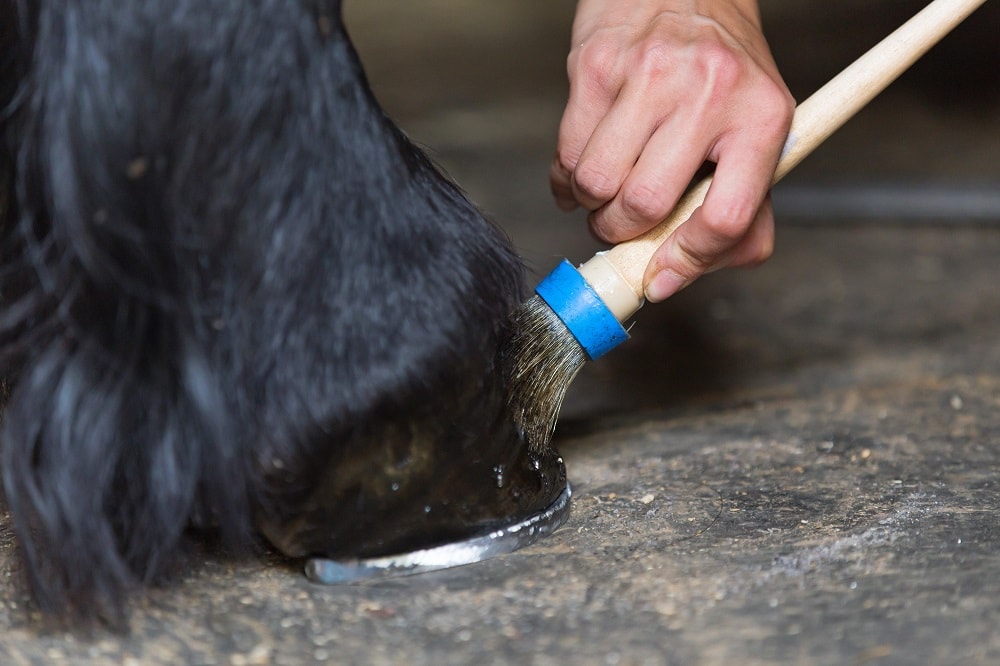
If you own a horse with a dull coat, you have probably received some advice to add oil to its diet to help increase the shine. High-quality oils can also help protect the skin and even reduce inflammation to help your horse feel better, especially older horses experiencing arthritis. However, many oil brands come from different sources, and it can be difficult to know which type of oil is best.
We’ve chosen seven brands of oil to review for you so you can learn about some of the differences between them. We’ll tell you the pros and cons we experienced while using each, and whether or not it worked for our horses. We’ve also included a short buyer’s guide where we look at how these oils help and what you should look for as you shop.
Keep reading while we discuss ingredients, size, palatability, and more to help you make an educated decision.
A Quick Comparison of Our Favorites
The 7 Best Oils for Horse Coats – Reviews 2021
1. AniMed CoMega Supreme Oil – Best Overall
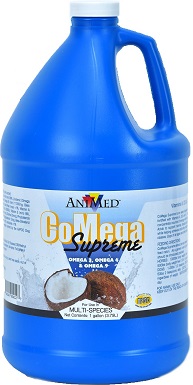
AniMed CoMega Supreme Oil is our choice for the best overall oil for a horse’s coat. It’s easy to digest and won’t upset your horse’s stomach or cause diarrhea. It has several oils in its ingredients, including soybean, coconut, rice bran, and flaxseed oil, all of which will help provide balanced nutrients. It’s fortified with vitamin A, D3, and E for eye and bone health. Omega fats 3, 6, and 9 will help improve your horse’s coat so it’s shiny and healthy.
The only problem we had with AniMed was the packaging. It arrived leaking, and there was oil all over the bottle. When we went to complain online, we noticed several other people had the same problem.
Pros
- Easy to digest
- Fortified with vitamin A, D3, and E
- Fortified with omega-3, 6, and 9
- 1 gallon
2. Uckele Cocosoya Oil – Best Value
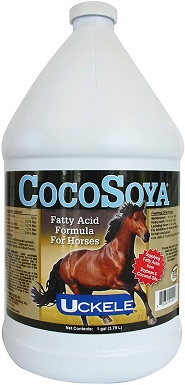
Uckele Cocosoya Oil is our pick as the best oil for a horse’s coat for the money. It has soybean oil and coconut oil in the ingredients, which will provide your horse with omega fats that will help promote a healthy coat, protect the skin, and even reduce inflammation. It’s easy to digest and comes in a large, 1-gallon container.
We enjoyed giving Uckele to our horses. The only problem we had was that one of our horses wouldn’t eat anything we put it on.
Pros
- Promotes a shiny coat
- Easy to digest
- Contains lots of omega fats
- 1 gallon
Cons
- Some horses don’t like it
3. AniMed Fish Oil – Premium Choice
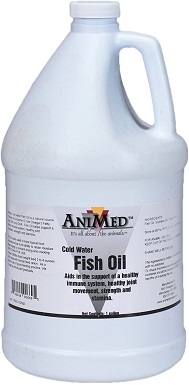
The AniMed Fish Oil is our premium choice oil for a horse’s coat. It uses fish and soybean oil to provide your horse with omega fats that will help improve coat health. It’s easy to digest and won’t give your pet diarrhea, plus, it has no odor despite containing fish oil. It comes in a large 1-gallon container that will last you several months.
Fish oil is one of the best sources of omega fats and is the source of most human omega fats. However, it’s quite expensive, and AniMed is one of the costliest oils on this list. There is also no way to tell how much fish oil you get mixed with soybean oil.
Pros
- 1 gallon
- Soybean oil and fish oil
- Odorless
- Easy to digest
4. Vital Pet Life Salmon Oil
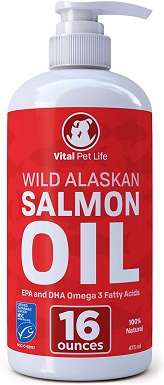
Vital Pet Life Salmon Oil comes in a 16-ounce container and contains only one ingredient, Alaskan salmon oil. This oil will provide your horse with plenty of important omega-3 fats that are not only great for a shiny coat but also help reduce inflammation, which is especially helpful to relieve the symptoms of arthritis. It also helps protect the skin and puts a watertight barrier on the hooves.
We felt that Vital Pet Life Salmon Oil provides you with a good amount of fish oil for the price, but the bottle is too small for a horse, and you will need to resupply frequently. It has a fishy odor that some owners and horses might not like, and one of our horses wouldn’t eat it.
Pros
- 16 ounces
- Contains lots of omega fats
- Alaskan salmon oil
Cons
- Fishy odor
- Some horses don’t like it
5. Shapley’s No. 1 Light Oil

Shapley’s No. 1 Light Oil is for treating your horse’s coat directly with a topical spray. As the name suggests, it’s a light mineral oil that won’t rub off on surfaces or make the coat look oily. We found that it works especially well for detangling the mane and tail, and it can even help soothe dry and itchy skin. It comes in a 32-ounce spray bottle that can last several applications depending on how you use it. As an added bonus, there is no odor.
The primary downside of Shapley’s No.1 Light Oil is that the nozzle is nearly impossible to use and breaks quickly, leaking oil all over your hand. There is also no nutritional value in a topical oil, and the coat will only stay shiny as long as the oil is present.
Pros
- Topical use
- Detangles mane and tail
- 32 ounces
Cons
- Poor spray nozzle
- No nutritional benefit
6. Knotty Horse Apricot Oil
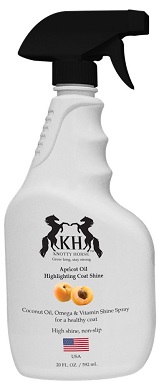
Knotty Horse Apricot Oil is another topical brand, and it uses a unique blend of oils that includes apricot, coconut, radish, and meadowfoam oils. It has vitamin A and E fortification and contains helpful omega 6 and 9 fats that will absorb quickly into the skin and help you achieve the shiny coat. It’s a non-greasy formula that works well at removing tangles.
Knotty Horse Apricot Oil is good at removing tangles, but the small 20-ounce bottle will not go far if using it to make the coat shiny. It also has quite a bad smell that some horse owners might not like.
Pros
- Unique oil blend
- Vitamins A and E
- Contains omega 6 and 9
- Non-greasy
- Good for tangles
7. UltraCruz Flax Oil Blend
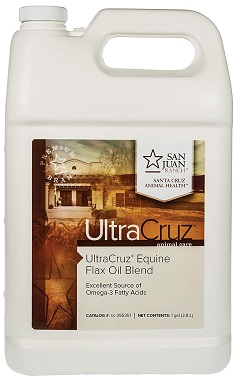
The UltraCruz Flax Oil Blend is a 1-gallon container of flax and soybean oil that is easy for your horse to digest. It contains both omega-3 and 6 fatty acids that will help make your pet’s coat shiny and healthy. It’s formulated especially for horses and will also help improve the health of the skin and hooves. The large size of the container will last for several years.
The downside to UltraCruz oil is that it has a distinctive bad smell due to the flax. The omega-3 content is also quite low in this brand and will be of little help compared to other brands
Pros
- 1 gallon
- Flax and soybean oil
- Easy to digest
Cons
- Bad smell
- Low omega-3content
Buyer’s Guide
Here are a few things you should consider before you purchase oil for your horse’s coat.
How Much Oil Do I Need?
The amount of oil you will need will depend on what you want to accomplish. To achieve a shinier coat, you will only need 1-2 ounces per day. A horse that is looking to gain or maintain weight can consume up to 16 ounces per day.
Fatty Acids
You will see that many brands contain omega-3, 6, and 9 fatty acids. These fats are essential for a shiny coat and have many other functions in the body as well, including improving mental functions. Omega-3 fats especially will help reduce inflammation and can help ease joint pain associated with arthritis. However, omega-6 fats can cause inflammation, and you should try to avoid foods and oils that contain them.
Oils That Are High In Omega-3 Fats
Oils That Are High In Omega-6 Fats
Oils That Are High In Both
Internal Versus Topical
Topical
Topical oils are essential for removing tangles and knots in the horse’s mane and tail. The skin will absorb some of the oils if you rub it through the fur, but most will remain on the hair. It can help make the coat shiny, but the results are only temporary. Inexpensive brands will rub off on the floor and can make the hair feel greasy or oily. It can also make the horse smell bad.
Internal
When your horse eats the oil, it works to improve the animal’s coat from the inside. It can help the hair grow thicker and shinier and help improve your pet’s health. The healthier hair will also keep its shine longer than it would with a topical oil. The downside to feeding your horse oil is that it could cause it to gain weight.
We recommend using an internal oil to help keep a shiny coat and using the topical brands for detangling.

How Do I Feed My Horse Oil?
Most owners will feed their horse oil by adding it to its regular feed. Your horse will hardly notice the 1-2 ounces required to keep the coat shiny. Even the 8-16 ounces used to add healthy fat and calories to the diet will go mostly unnoticed. Some horses will like some oils better than others, and some horses might not like one kind, but most will consume the oil without much trouble.
Conclusion
When choosing an oil for a horse’s coat, we recommend an internal product so the hair will be stronger and the skin will be less likely to be dry and itchy. We highly recommend our pick for the best overall. The AniMed CoMega Supreme Oil is easy to digest and contains plenty of vitamins. It also contains omega-3, 6, and 9 fatty acids that will help produce a healthy and shiny coat. Our pick for the best value is another smart choice. Uckele Cocosoya Oil is inexpensive and comes in a large container, so it will last quite a while. It also contains the omega fats your horse needs for a shiny coat.
We hope you have enjoyed reading over these reviews and found one that you feel good about using. If we have helped you, please share this guide to the best oil for a horse’s coat on Facebook and Twitter.
Check out some of our other top-trending horse posts:
Featured Image Credit: Osetrik, Shutterstock
Ed Malaker is a veteran writer who has contributed to a wide range of blogs that cover tools, pets, guitars, fitness, and computer programming. When he’s not writing, Ed is usually performing DIY projects around the house or working in the garden. He’s also a musician and spends a lot of time helping people fix their guitars and composing music for independent films.






